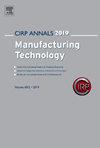Ultrasonic assisted abrasive nano-blasting
IF 3.6
3区 工程技术
Q2 ENGINEERING, INDUSTRIAL
引用次数: 0
Abstract
This research introduces abrasive nano-blasting using fine abrasive particles. Fine abrasive particles are difficult to use in abrasive blasting due to tendency of forming agglomerates caused by prevalent surface forces. The pressure gradient and streaming effect of ultrasonic vibration is utilized to break the abrasive agglomerates before impacting the workpiece for polishing. It could be observed through simulations that the pressure gradient to overcome the adhesive forces and breaking the agglomerates can be theoretically achieved. Polishing experiments revealed that acoustic streaming inside the ultrasonic cavity also improved uniform surface generation with up to 67 % reduction in surface roughness Sa.
超声辅助磨料纳米爆破
本研究介绍了利用细磨粒进行磨粒纳米爆破。由于普遍存在的表面力,细小的磨料颗粒容易形成团块,因此难以用于喷砂。利用超声振动的压力梯度和流场效应,使磨料团块破碎后再冲击工件进行抛光。通过模拟可以观察到,理论上可以实现克服附着力和破碎团聚体的压力梯度。抛光实验表明,超声腔内的声流也改善了均匀表面的生成,表面粗糙度Sa降低了67%。
本文章由计算机程序翻译,如有差异,请以英文原文为准。
求助全文
约1分钟内获得全文
求助全文
来源期刊

Cirp Annals-Manufacturing Technology
工程技术-工程:工业
CiteScore
7.50
自引率
9.80%
发文量
137
审稿时长
13.5 months
期刊介绍:
CIRP, The International Academy for Production Engineering, was founded in 1951 to promote, by scientific research, the development of all aspects of manufacturing technology covering the optimization, control and management of processes, machines and systems.
This biannual ISI cited journal contains approximately 140 refereed technical and keynote papers. Subject areas covered include:
Assembly, Cutting, Design, Electro-Physical and Chemical Processes, Forming, Abrasive processes, Surfaces, Machines, Production Systems and Organizations, Precision Engineering and Metrology, Life-Cycle Engineering, Microsystems Technology (MST), Nanotechnology.
 求助内容:
求助内容: 应助结果提醒方式:
应助结果提醒方式:


